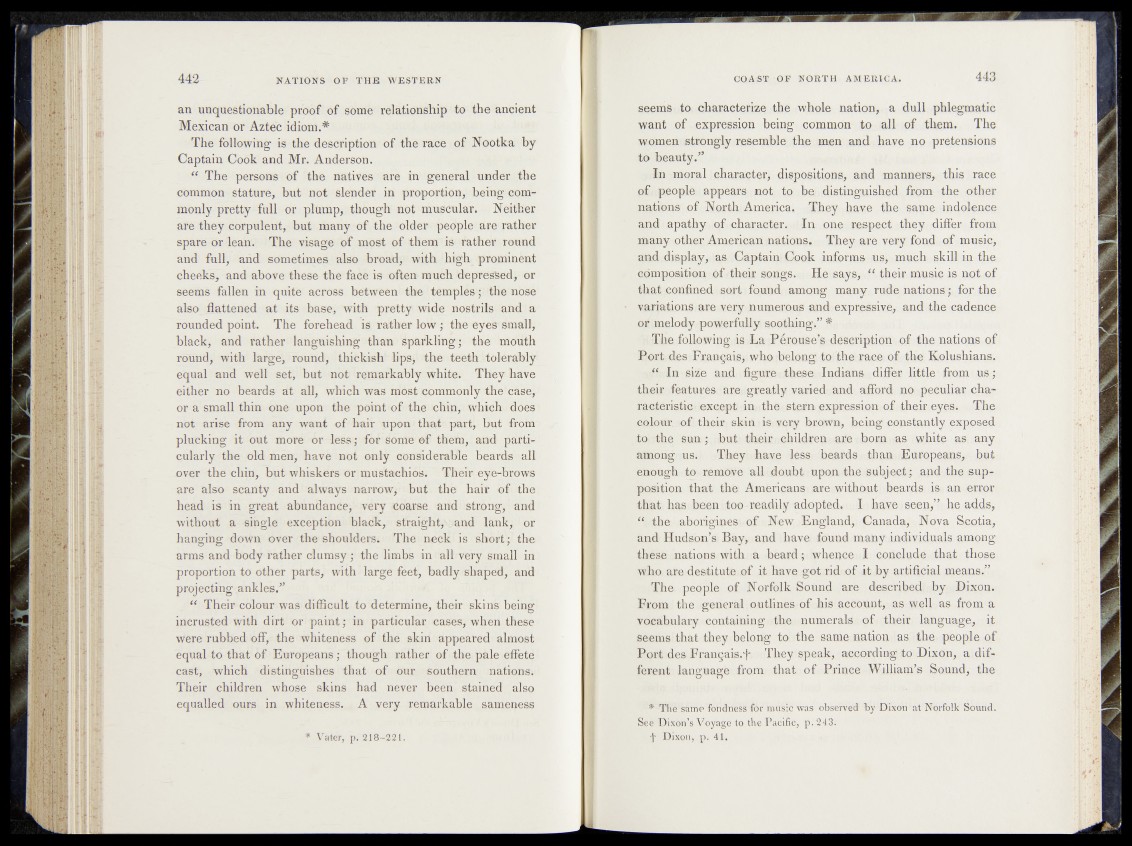
an unquestionable proof of some relationship to the ancient
Mexican or Aztec idiom.*
The following is the description of the race of Nootka by
Captain Cook and Mr. Anderson. .
“ The persons of the natives are in general under the
common stature, but not slender in proportion, being'commonly
pretty full or plump, though not muscular. ^ Neither
are they corpulent, but many of the older people are rather
spare or lean. The visage of most of them is father round
and felly and sometimes also broad, with high prominent
cheeks, and above these the face is often- much depressed* or
seems fallen in quite across between5 the templi&’pthe nose
also flattened at its base; with pretty wide nostrils and a
rounded point. The forehead is rather low; theeyeksmall*
black, and rather languishing than sparkling; the mouth
round, with large, round, thickish lipsy th e teethitoleraMy
equal and well set, but not remarkably white; They lidVe
either no beards at all, which was most commonly the case;
or a small thin one upon the point^of the chin, whicbidbes
not arise from any want of hair upon that part, but #oin
plucking it out more ordess; forborne ©f them, and pgltth
cularly the old men, have not only considerable beards all
over the cliin, but whiskers or mustaebioSi ^Thetr mfO-brows
are also scanty and always narrow,- but the hair of the
head is in great abundance, very coarse -andf! strong/» and
without a single exception bladk, st'raight,v and lank, ’ or
hanging down over the shoulders. The i neck is short ; the
arms and body rather clumsy; the limbs in all very small in
proportion to other parts, with large feet, badly shaped, and
projecting .ankles.”
“ Their colour was difficult to determine, their skins being
inerusted with dirt or paint; in particular eases, when these
were rubbed off, the whiteness of the skin appeared almost
equal to that of Europeans ; though rather of -the pale effete
cast, which distinguishes th a t of our southern nations.
Their children whose skins had never been stained also
equalled ours in whiteness. A very remarkable sameness
* Vater, p. 218-221.
seems. tnchmacterize the whole nation* a dull phlegmatic
want of | expression being common to all of them. The
women strongly resemble the men and have $10 pretensions
to beauty.”
3, In .moral |character, dispositions, and manners, this race
pfo,people appears not to’ bo distinguished from the other
NorthAmjepca* „They the 4?ame indolence,
and apathyptafechar.acter. Intone respect,'they differ from
many other American nations. They are very fond of music,
and display,; tas. CapfeaintlQoQk inarms i#*:much skill in the
songs. . He, says, “ their music is not of
that confined sort j found among many rude, nations: lor the
variations ; are very numerous and expressive, and the cadence
or smelody powerfully seething*’’ f
The following? âsLa PereUse’s- description of the nations of
B©rtffeS'Fmnyais,i who belong; to the raee.- o fth e Kolushians.
, “ In si'ie and figure those Indians differ little ffom us ;
their features arOi greatly varied and afford- npiipecellar characteristic
| except• in.*the-;stern cxpession of their,eyes. The
colour of their skin • iss very brown, being constantly exposed
to? ;the sun ; but their children are born $,s whitpnsuany
among .usc- They have le&s> beards than Europeans, but
enough remove afi doubt?upon the subject; and thesup-r
position that the Americans are without beards is- an error
that has beentoo-readily adopted. I have j seen,” -, he adds,
■^dhe.'.aboii^nesf-of ,New England* Qanadâ; Nova Scotia,
and Hudson’s Bay, and have found many individuals among
these nations with a beard; whence-:! eoncludethat those
who are destitute of it have got rid ofoitby artificial means.”}.
The people of Norfolk Sound are described by Dixon.
From the general| outlines of his account, as well as from a
vocabulary-1conteining ■ tb e numeralsf ^ their language,.| it
seems that they belong to the same nationdas the. people of
Port des Français.f Theyfffseak, aecordingfo Dixon, a different
language from that« of Prince - IWilliam’s fjfound, the
* Thé same fowdufes^'fèr tousle Sotódt.
See Dixon’s Voyage to the Pacific, p. 243.-
■ •f Dixon, p. 41.